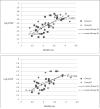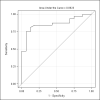Relationship of main pulmonary artery diameter to pulmonary arterial pressure in scleroderma patients with and without interstitial fibrosis
- PMID: 24448503
- PMCID: PMC3959588
- DOI: 10.1097/RCT.0b013e3182aa7fc5
Relationship of main pulmonary artery diameter to pulmonary arterial pressure in scleroderma patients with and without interstitial fibrosis
Abstract
Objective: This study aimed to determine the relationship between main pulmonary artery diameter (MPAD) and pulmonary hypertension (PH) in scleroderma patients with and without interstitial lung disease.
Methods: We retrospectively reviewed 48 subjects with scleroderma who underwent a chest computed tomography (CT) and right heart catheterization with 6 months of each other. Patients were divided into 2 groups based on the absence or presence of interstitial lung disease on chest CT. Subset analysis was performed based on available pulmonary function tests and divided into groups by forced vital capacity (FVC). Computed tomographic scans were scored for extent of fibrosis and ground glass opacity. Pulmonary artery and ascending aorta measurements were obtained by 2 independent observers. Univariate and multivariate models were used to evaluate the correlation between MPAD and mean pulmonary artery pressure (mPAP) measured by right heart catheterization. Receiver operating characteristic analysis was performed for diagnostic accuracy of the MPAD measurement in predicting PH.
Results: Strong correlations between mPAP and MPAD were found in this study regardless of the presence or absence of mild to moderate interstitial fibrosis on chest CT. When dividing patients based on FVC, the correlation between mPAP and MPAD was substantially attenuated. An MPAD value of 30.8 mm yielded the highest sensitivity and specificity at 81.3% and 87.5%, respectively.
Conclusions: In scleroderma patients, an enlarged main pulmonary artery (>30 mm) predicts PH even in the presence of mild to moderate fibrosis although the relationship may be attenuated in the presence of a low % FVC.
Figures
Similar articles
-
Predictors of pulmonary hypertension on high-resolution computed tomography of the chest in systemic sclerosis: a retrospective analysis.Can Assoc Radiol J. 2010 Dec;61(5):291-6. doi: 10.1016/j.carj.2010.02.006. Epub 2010 Apr 10. Can Assoc Radiol J. 2010. PMID: 20382500
-
Utility of CT scan evaluation for predicting pulmonary hypertension in patients with parenchymal lung disease. Medical College of Wisconsin Lung Transplant Group.Chest. 1998 May;113(5):1250-6. doi: 10.1378/chest.113.5.1250. Chest. 1998. PMID: 9596302
-
CT measurement of central pulmonary arteries to diagnose pulmonary hypertension (PHTN): more reliable than valid?Clin Imaging. 2016 Jul-Aug;40(4):821-7. doi: 10.1016/j.clinimag.2016.02.024. Epub 2016 Feb 27. Clin Imaging. 2016. PMID: 27131412
-
Pulmonary hypertension in chronic lung diseases.J Am Coll Cardiol. 2013 Dec 24;62(25 Suppl):D109-16. doi: 10.1016/j.jacc.2013.10.036. J Am Coll Cardiol. 2013. PMID: 24355635 Review.
-
Imaging Approach to Pulmonary Hypertension.Radiol Clin North Am. 2025 Mar;63(2):193-205. doi: 10.1016/j.rcl.2024.07.002. Epub 2024 Aug 15. Radiol Clin North Am. 2025. PMID: 39863374 Review.
Cited by
-
Diameter of the dilated main pulmonary artery in patients with pulmonary hypertension decreases after lung transplantation.Surg Today. 2020 Mar;50(3):275-283. doi: 10.1007/s00595-019-01887-6. Epub 2019 Oct 8. Surg Today. 2020. PMID: 31595367
-
Association between cardiovascular risk factors and the diameter of the main pulmonary artery in asymptomatic population in the Appalachian region.J Thorac Dis. 2019 Aug;11(8):3435-3442. doi: 10.21037/jtd.2019.08.09. J Thorac Dis. 2019. PMID: 31559048 Free PMC article.
-
Prognostic impact of the ratio of the main pulmonary artery to that of the aorta on chest computed tomography in patients with idiopathic pulmonary fibrosis.BMC Pulm Med. 2019 Apr 18;19(1):81. doi: 10.1186/s12890-019-0843-5. BMC Pulm Med. 2019. PMID: 30999878 Free PMC article.
-
Risk factors for haemoptysis after percutaneous transthoracic needle biopsies in 4,172 cases: Focusing on the effects of enlarged main pulmonary artery diameter.Eur Radiol. 2018 Apr;28(4):1410-1419. doi: 10.1007/s00330-017-5101-8. Epub 2017 Oct 23. Eur Radiol. 2018. PMID: 29063253
-
Non-invasive screening for pulmonary hypertension in idiopathic pulmonary fibrosis.Respir Med. 2016 Aug;117:65-72. doi: 10.1016/j.rmed.2016.06.001. Epub 2016 Jun 2. Respir Med. 2016. PMID: 27492515 Free PMC article.
References
-
- Steen VD. The lung in systemic sclerosis. J Clin Rheumatol. 2005 Feb;11(1):40–46. - PubMed
-
- Trad S, Amoura Z, Beigelman C, et al. Pulmonary arterial hypertension is a major mortality factor in diffuse systemic sclerosis, independent of interstitial lung disease. Arthritis Rheum. 2006 Jan;54(1):184–191. - PubMed
-
- Wigley FM, Lima JA, Mayes M, McLain D, Chapin JL, Ward-Able C. The prevalence of undiagnosed pulmonary arterial hypertension in subjects with connective tissue disease at the secondary health care level of community-based rheumatologists (the UNCOVER study). Arthritis Rheum. 2005 Jul;52(7):2125–2132. - PubMed
-
- Chang B, Schachna L, White B, Wigley FM, Wise RA. Natural history of mild-moderate pulmonary hypertension and the risk factors for severe pulmonary hypertension in scleroderma. J Rheumatol. 2006 Feb;33(2):269–274. - PubMed
-
- Haimovici JB, Trotman-Dickenson B, Halpern EF, et al. Relationship between pulmonary artery diameter at computed tomography and pulmonary artery pressures at right-sided heart catheterization. Massachusetts General Hospital Lung Transplantation Program. Acad Radiol. 1997 May;4(5):327–334. - PubMed
Publication types
MeSH terms
Grants and funding
LinkOut - more resources
Full Text Sources
Other Literature Sources
Medical




